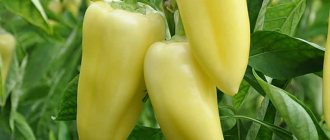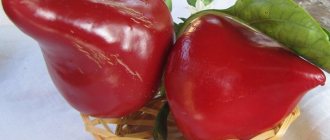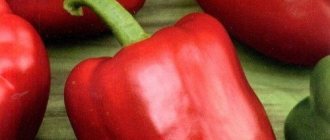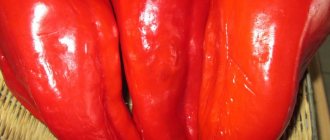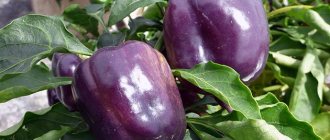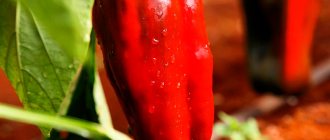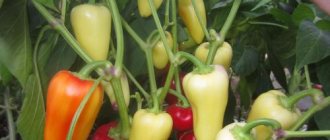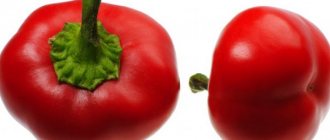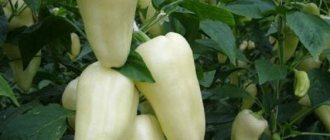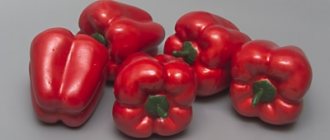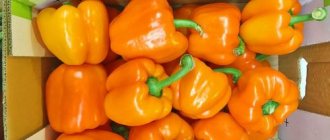Features of early varieties
Early ripening varieties are species that bear fruit 90-120 days after planting the seeds.
Even this growing season is not sufficient to complete the entire growth cycle. Pepper is a heat-loving vegetable; it is planted in the ground in the second ten days of May. To speed up the ripening process, it is recommended to first plant seedlings, which are prepared starting in mid-February. Heat-loving plants are afraid of spring frosts and temperature changes. The plant may slow down and lose leaves. Scientists agronomists have developed more than 30,000 varieties of pepper, of various shapes and colors. The color range varies from white to black. They come in yellow, orange, red, chocolate and especially rarely purple. The forms of pepper are also different:
- cone-shaped;
- pyramidal;
- having the appearance of a turban or saber.
The weight of the pepper is also different: there are very small (about 50 g) and large sizes (up to 350 g).
They are intended for:
- fresh consumption;
- canning;
- freezing;
- pickling;
- for stuffing.
Ultra early ripening peppers
Attention! In addition to varieties for greenhouses, universal species have also been bred.
Such ultra-early ripening plants develop well in open ground conditions.
Cardinal
This early sweet species is intended exclusively for growing in a greenhouse. It does not exceed 1m in height. Very fleshy fruits. Their color is unusual - from green and red to dark purple. This is not a pure variety, it belongs to hybrids.
Denis
It can rightfully be called ultra-early. This sweet pepper ripens in a greenhouse in a minimum amount of time - 100 days. The fruits are very large and dense, reaching 400 g in weight. The bush itself is small in height, very compact.
Claudio
This ultra-early variety is intended for large greenhouses. In low film buildings the plant will be cramped. Its fruits are large in shape and burgundy in color. Their weight ranges from 200 to 250 g. The plant itself is large. It can reach a height of more than 125 cm. The bush is spreading and has many branches.
Atlant
This plant grows ideally in a small greenhouse. The early variety of pepper does not grow higher than 85 cm and still gives a good harvest. The fruits are fleshy, juicy and large. The color when ripe will be green. Over time, the pepper will turn red.
Cockatoo
It grows very large (up to 1.5 m) and spreading. To grow this early variety you need a large greenhouse. This is an ultra-early ripening species; 100 days are enough for it to fully mature. The weight of the fruit is very large. With proper care – 500 g.
Madonna
This is a hybrid ultra-early representative. The fruits have grown quite large, their weight reaches approximately 200 g. The peppers are fleshy, with thick walls of 7 mm. When fully ripe, the fruit has a rich yellow color. The plant is small in height
.
Hercules
It has a long shelf life and rapid ripening. That is why this early species is often grown in greenhouses for sale. The fruits are quite fleshy and large, weighing up to 300 g. In general, the plant is not picky and resists diseases well.
Snow White
This plant belongs to the ultra-early ripening variety. But it is intended only for film greenhouses. In other conditions, the plant will develop, but the yield will decrease. The fruits are colored white. As the peppers ripen, they turn red. The height of the bush is small.
Latino
This is an ultra-early ripening variety of sweet pepper. In the right greenhouse conditions, it gives a large harvest - up to 14 kg per 1 square meter. The bush is tall (1m), but compact. Ripe fruits have an even red tint. This is one of the best hybrid representatives.
Dwarf
This variety is distinguished by its small growth. Usually the plant reaches a height of no more than 35-40 cm. This is how it earned its popularity (it is much easier to care for). The fruits of this pepper weigh about 80 g, but they are quite fleshy.
Lumina
A very popular ultra-early variety. The variety is very resistant to diseases. Changing conditions is also not a hindrance for him. Small in height, compact in stature. The fruits are small, weighing no more than 115 g. The color is different - white, gold, green, pink. Pale shades.
Winnie the Pooh
The height of the plant does not exceed 30 cm. The fruits are small, they weigh only 50 g. But the species is quite popular. It is often used to prepare gourmet dishes. Another big plus is simultaneous maturation.
Ivanhoe
This early species loves warmth and moisture. It belongs to the medium-sized varieties, but in general it is very compact. The yield is good, but under the right conditions - 7.5 kg per 1 m2. The color of the pepper can be combined, or it can be even. These are mainly shades of red and orange.
Marinka's tongue
The fruits of this ultra-early ripening species ripen very early. At the same time, its resistance to diseases and changes in the environment is quite high. The plant is of medium height (about 60 cm). One bush grows up to 15 fruits weighing 240 g. The color is even, dark red.
Triton
This early representative is characterized by a high degree of resistance to diseases, pests, changing conditions, and so on. Very high yield - about 40 small or medium fruits per bush. The fruits are quite fleshy, wall thickness 6 mm. Colors – red, yellow, orange.
So, we looked at the best ultra-early varieties of peppers for greenhouse cultivation. Now let's look at the seed selection criteria.
How to choose a variety
To decide on a variety, you should outline the requirements:
- increased harvest;
- resistance to various diseases;
- resistance to low temperatures;
- decent taste;
- sufficient fleshiness of the fruit;
- adaptability to any soil composition;
- ease of care.
Breeders advise choosing early-ripening varieties, especially for gardeners in the Urals and Siberia regions, so that in a short summer the vegetables have time to ripen and produce a harvest. Taking into account the listed factors, agronomists can make a choice of a specific variety suitable for a particular site.
In greenhouse conditions it is better to grow indeterminate varieties. Such plants grow up to 1 meter in height, and several kg of vegetables can be harvested from each. Low varieties can be planted in open beds so that they are not damaged by wind or rain. It will be easier to harvest from them. Attention should be paid to varieties that are resistant to cold temperatures and diseases.
Early pepper varieties for open ground: reviews from those who grow
Olga, 45 years old, Barnaul: I have long wanted to grow bell peppers in open ground on my plot, but I couldn’t find a suitable variety that would be resistant to our unpredictable climate. Finally, I purchased the seeds of the Siberian Prince pepper, which was specially bred for cultivation in our region in open ground. The variety turned out to be high-yielding, and the fruits were quite large and tasty. I use the harvested crop not only for food, but also for preservation. Lecho is especially tasty. I recommend it for cultivation to all vegetable growers from Siberia and the Urals.
Natalya, 50 years old, Ulyanovsk: I have been growing bell peppers for many years. But last year I wanted to plant something new and unusual. My choice fell on the Hannibal pepper variety - I was attracted by the unusual, slightly shocking name. Its fruits are prism-shaped and turn brown when ripe. The yield of the variety is not bad, the taste of ripe vegetables is excellent. Especially unusually ripe fruits look in a salad.
Tatyana, 35 years old, Ryazan: I grow early varieties of bell pepper on my plot for further sale. Therefore, I choose varieties with high yields that bear fruit well in open ground, since I don’t have a greenhouse on my site, and at the same time with excellent external characteristics. Recently I have been growing the Charming variety, the yield of which suits me quite well - up to 12 kg of ripe produce from one square square of area.
Svetlana, 55 years old, Volgograd: I grew different varieties of pepper in the garden; in our warm climate, this vegetable plant grows and bears fruit well. I try to grow already proven varieties, but every year I allocate one bed for some new variety or hybrid. I really liked the early Belladonna pepper, suitable for open ground. This hybrid begins to bear fruit already 90 days after the sprouts appear; the fruits are quite large and have a cuboid shape. I use the harvest of this variety mainly for food - salads or snacks.
Early ripening varieties
The most popular agricultural companies growing peppers are Sedek and Gavrish. A variety is the selection of a specific type of seed. It is adapted to the climatic characteristics of the region. When pollinated, the plant produces seeds of the same variety. Large planting material is selected for further propagation.
The hybrid is obtained as a result of crossing. They are the most productive and less susceptible to disease. But the main thing is their peculiarity: you cannot get seeds from them. The “F1” sign is written on the bag of hybrid seeds.
Below are ratings of varieties that have early ripening periods.
Lumina
It is an early ripening variety, its fruits are one of the first to appear on sale in the spring.
- easy to care for;
- not picky about soil;
- not afraid of drought and bad weather conditions.
A medium-sized fruit weighs about 100 grams. The color is greenish, rarely with a pink tint. The fruit itself has a cone shape, a sweet taste, and the flesh is watery.
The fruits can be used for stuffing and pickling. Lumina can be transported and has a long shelf life.
Ivanhoe
The fruits ripen on the 120th day of planting, are colored red or orange, have a sweetish taste, and a pronounced aroma.
One pepper can weigh about 120 grams, the fruit is shaped like a cone. Inside the fruit there are partitions into 4 chambers, and there are a large number of seeds in the cavity. Suitable for planting in open ground or greenhouses. One bush ripens about 8 kg. Lack of watering reduces yields. Ivanhoe is rarely affected by diseases; the fruits are used in canning and preparing salads.
Maryin language
The pepper variety has stable yields even when grown in unfavorable conditions.
- Gardeners harvest up to 13 kg of fruit on one bush.
- The bush usually grows up to 70 cm, the vegetable requires tying.
- The color of the pepper changes from cherry to bright orange, the shape of the fruit is in the form of a cone.
Peppers of this variety are suitable for preservation or for use in salads. The taste is sharp-sweet, with a slight bitterness.
Triton
Brought out by breeders as a super-early variety.
From 1 bush, under favorable conditions, you can collect about 40 peppers. The color of the vegetable varies from yellow to orange. Has proven itself well when grown in Siberia. The peculiarity of the variety is that the first ovaries must be removed. In the absence of such manipulations, growth will decrease and there will be few fruits. The taste is sweet and quite pleasant, but Triton has a short shelf life, so it’s better not to store it.
Atlant F1
Refers to hybrid varieties.
- The height of the bush is about 100 cm, can be planted in greenhouse conditions and requires mandatory supports.
- The fruits are quite large – about 300 g, barrel-shaped, slightly elongated.
Thin-walled varieties of peppers for stuffing
Each housewife has her own preferences in preparing stuffed peppers. Some people don’t really like the taste of boiled pepper, while others like the harmonious combination of vegetable and filling. As they say: “there are no comrades according to taste.”
For those gardeners who prefer filling in this dish, we offer a selection of varieties and hybrids with relatively thin walls.
Pepper variety "Swallow"
The first on this list will be “Swallow” - an old, proven and beloved variety by many gardeners, quite unpretentious, with excellent taste. The fruits have a conical shape, which is very convenient if you are stuffing peppers for the winter.
Variety "Swallow"
They can be placed tightly, one to one, in jars. Thus, both the container and the amount of filling are used rationally.
The thickness of the walls of the fruit is about 5 mm, height – up to 10 cm, weight – about 100 g.
The variety is mid-season - 115-120 days from germination, with a yield of up to 5 kg/1m2.
Sweet pepper "Triton"
An early variety of sweet pepper with high resistance to unfavorable conditions and high yield of an equally good harvest during periods of prolonged rains, lack of sun and temporary drops in temperature.
Variety "Triton"
The fruits, weighing 140 g, can be bright red, yellow and orange in color, but are equally tasty and juicy. Wall thickness 6-8 mm.
The harvested crop can last for about 1.5 months if storage rules are followed.
"Funtik"
Quite a large variety (up to 180 g) with cone-shaped fruits. The thickness of the pulp layer is average - no more than 7 mm, the height of the bush can reach 70 cm.
Variety "Funtik"
In this case, the plant requires a mandatory garter. The variety has a moderately sweet and rich taste. Resistant to tobacco mosaic virus. Fruits removed from the bush retain their presentation and taste for 2.5 months.
Sweet pepper "Temp"
The sweet variety Temp is marked F1 and is characterized by increased yield and smooth ripening of fruits. The taste of small (120 g) peppers is rich. The pulp layer is 5 mm.
Variety "Temp"
The hybrid is resistant to all major pepper diseases. Keeps fresh for 3 months.
"Lotta F1"
Hybrid pepper with good yield and universal purpose. The height of the bush is 55 cm, the weight of the fruit is up to 160 g, the thickness of the walls is up to 7 mm.
Variety F1 "Lotta"
Delicious. Resistant to diseases. It is stored for about 2 months.
Sweet pepper variety for stuffing “Semko 2013 F1”
An early-ripening hybrid with a bush height of about 60 cm. The fruits are shaped like a truncated cone, with slightly pronounced ribbing. During the period of technical ripeness (100 days from germination), the color of the peppers is light green. During the period of full ripening (120-135 days from germination) – yellow.
Variety "Semko 2013" F1
The weight of one fruit also depends on the degree of ripeness. In the technical stage it is 80-100 g, in the biological stage - 120-150 g. The wall thickness is 5-7 mm.
The hybrid is resistant to tobacco mosaic and verticillium wilt. Suitable for growing in greenhouses and open ground. The yield in the first case is 7-9 kg/m2, in the second – 5-7 kg/m2.
Pepper can be stored for about 2 months without loss of quality.
"Czardas"
This variety also has a two-month harvest shelf life. But its peculiarity lies in the fact that the fruits can be eaten already at the stage of early technical ripeness.
Variety "Csardas"
The height of the bush is on average 60 cm, the fruits weigh up to 220 g, but are not very fleshy. The wall thickness is 6 mm.
The coloring of the cone-shaped peppers is also noteworthy. It changes from a lemon-yellow hue (at the beginning of ripening) to a rich orange color during the period of biological maturity.
Sweet pepper "Eroshka"
An early-ripening and productive variety, recommended for compacted planting, 12-15 cm between plants. The average height of the bush is 35 cm and up to 15 cuboid-shaped fruits can ripen on it.
Variety "Eroshka"
The weight of one is 140-180 g, the thickness of the pulp is 5 mm. The variety is resistant to verticillium, blossom end rot, and tobacco mosaic.
"Belozerka"
This variety is also known as Lumina. It is one of the first to appear on the market and is popular.
Variety "Belozerka"
During the period of technical ripeness, the color of the fruit is white-yellow, in biological ripeness it is red. The weight of one pepper ranges from 75 to 140 g, and the height of the bush is from 40 to 70 cm. The wall thickness is 5-6 mm.
Mid-early variety (110-115 days), universal purpose. It has high shelf life and transportability.
The plant is resistant to major pepper diseases.
LiveInternetLiveInternet
—Categories
- FISHING (1)
- (0)
- CAR (0)
- AUDIO (43)
- health (4)
- books (22)
- music (17)
- VIDEO (128)
- Crochet (38)
- Knitting (50)
- for the garden (10)
- health (13)
- cooking (12)
- ALL ABOUT SALT (1)
- BAKERY (831)
- pancakes and pancakes (75)
- bread machine (9)
- buns, pies (82)
- fillings (8)
- baking decoration (51)
- cookies (140)
- savory pies (107)
- sweet pies (76)
- dough (94)
- cakes (194)
- KNITTING (106)
- For luxurious ladies (86)
- programs (11)
- KNITTING FOR CHILDREN (500)
- CROCHET (2369)
- berets, hats (8)
- jackets, vests (372)
- suit (75)
- summer blouses, tops (494)
- coat (27)
- blankets (241)
- pillows (11)
- potholders (56)
- miscellaneous (320)
- bags (88)
- slippers (47)
- tunic (129)
- patterns (250)
- caps and hats (78)
- scarves, shawls (67)
- skirts (112)
- KNITTING (3999)
- berets, hats (52)
- for men (57)
- jackets, vests (736)
- summer blouses, tops (673)
- dresses, coats (95)
- blankets (42)
- pillows (9)
- pullover, sweater, jumper (536)
- miscellaneous (233)
- bags (7)
- slippers, socks, mittens (283)
- tunic (159)
- patterns (781)
- shawls, scarves (291)
- skirt (29)
- COUNTRY QUESTIONS (560)
- fertilizers, fertilizing (10)
- raspberry (1)
- agricultural technology (64)
- eggplant (10)
- melon (3)
- control of plant pests and diseases (46)
- grapes (13)
- Lawn (2)
- peas, beans. (1)
- beds (1)
- cabbage (14)
- potatoes (8)
- strawberry (14)
- onions, garlic and herbs (28)
- raspberries, blackberries (13)
- carrots (6)
- vegetable garden (3)
- cucumbers (54)
- pepper (9)
- Fruit trees (9)
- crafts for the garden (52)
- useful plants (2)
- irrigation systems (1)
- miscellaneous (45)
- radish, radish. (3)
- beets (6)
- green manure (9)
- currants, gooseberries (9)
- greenhouse (3)
- tomatoes (51)
- tree care (4)
- shrub care (4)
- flowers (66)
- HOUSE, APARTMENT (1)
- balcony ideas (1)
- BLANKETS (524)
- watermelon (3)
- Assorted (6)
- eggplant (37)
- jam (112)
- mushrooms (15)
- Freeze (4)
- zucchini (24)
- cabbage (40)
- Canned meat (3)
- Canned fish (1)
- cucumbers (32)
- pepper (24)
- tomatoes (56)
- salads, snacks (32)
- beets (8)
- sauces, adjika (33)
- LAW (3)
- HEALTH (290)
- for joints (66)
- TRADITIONAL MEDICINE (104)
- ambulance (6)
- INTERESTING (48)
- INTERNET (6)
- APARTMENT, HOUSE (0)
- CINEMA (9)
- HOUSE PLANTS (1)
- COMPUTER (186)
- COOKING (1163)
- poultry dishes (158)
- main courses (3)
- cook quickly (163)
- cook in pots (34)
- cook in a slow cooker (147)
- mushrooms (11)
- desserts (4)
- RECIPES COLLECTION (8)
- meat dishes (204)
- drinks (52)
- first courses (8)
- picnic (23)
- seasonings (6)
- miscellaneous (42)
- fish dishes (164)
- salads and snacks (55)
- lard (22)
- sauce (15)
- homemade cheeses (27)
- stuffed vegetables (14)
- PRAYERS (1)
- WISE THOUGHTS (5)
- YOU NEED TO KNOW that. (5)
- MOOD (29)
- USEFUL TIPS (135)
- HOLIDAY DISHES (76)
- NATURE (2)
- PARABLES (25)
- PSYCHOLOGY (6)
- HANDCRAFTS (62)
- MUSIC SITES (3)
- SITES YOU NEED (21)
- KNITTING SITES (12)
- COOKING SITES (16)
- MEDICAL SITES (2)
- POEMS (38)
- PHONE (1)
- SEWING (207)
PEPPER VARIETY TRITON
Wednesday, January 27, 2021 13:11 + to quote book
PEPPER VARIETY TRITON
Triton pepper belongs to the category of very early. It is highly resistant to the vagaries of weather, which often occur in the Moscow region. In addition, plants of this variety have perfectly adapted to the conditions of southern Siberia.
Triton pepper is grown under conditions of open planting in the ground, and farmers in the northern regions were able to achieve record yields, which are practically not inferior to southern varieties. From just one bush you can pick up to 50 or more juicy fruits. The fruits of Triton pepper are cone-shaped, have not very thick walls and reach a weight of up to 150 grams.
Upon reaching the technical maturity phase, the color of the fruits is yellow; in the biological ripening phase they become red. Triton peppers are excellent for any processing and canning. In order for plants to produce a particularly high yield, some special feature should be used when growing them.
When seedlings are planted directly into the ground, the first ovary of the bushes must be removed. If this is not done, the development of the bush will be extremely poor, and there will be no need to talk about a large harvest, since very few fruits are produced.
Thick-walled varieties of peppers for stuffing
Peppers with a meatier layer of pulp are also good for stuffing. Eating such a dish, without even looking, you know exactly what it was made from.
Pepper variety for stuffing “Pride of Russia”
An early variety of sweet pepper produces a yield of up to 15 kg per 1 m2 of planting area. With proper care and favorable conditions, up to 20 peppers can ripen on one plant.
Variety “Pride of Russia”
The bush is strong, tall (up to 80 cm), the fruits are light green at the beginning of ripening, and at the stage of full ripening they have a bright, rich red color. Suitable for growing in greenhouses and open ground. Of course, in unprotected soil the yield will be lower, up to 8 kg/m2.
The ripening period is 110-120 days, the weight of one pepper is 130 g, the wall thickness is 7-8 mm.
"Golden Miracle"
A short, but rather spreading, pepper bush, from which you can pick from 10 to 15 sweet and juicy fruits.
Variety "Golden Miracle"
Wall thickness 8-10 mm. The variety is suitable for growing in greenhouses and open ground.
Yellow sweet pepper "Golden Rain"
Peppers of the “Golden Rain” variety have a spherical shape with a wall thickness of up to 8 mm, and are also suitable for stuffing. With one “but”... They are good for serving straight to the table.
Variety "Golden Rain"
Much less often they are used to prepare stuffed peppers for the winter. The reason is still the same: it is impossible to pack tightly into jars. The peppers are trying to turn over.
Description and characteristics of the variety
Bell pepper Triton has very compact bushes, shaped like umbrellas, 30-50 cm high. There is no point in planting it in a greenhouse, but in the north it can be used to compact plantings when growing indeterminate varieties. In the center and south of Russia, this variety is intended for open ground.
Ripening is ultra-early - 75-80 days pass from germination to technical ripeness. The fruits have the following characteristics:
- large size – 100-150 g, according to other sources – up to 200 g;
- in technical ripeness a pale yellow hue;
- in biological maturity – red;
- cone shape;
- have 4 chambers with seeds;
- average walls – 4-5 mm;
- about 11 cm long.
The harvest can be used for fresh and canned salads, any dishes, including preparing stuffed peppers and lecho. The pulp is sweet, juicy, with excellent taste, and contains a lot of vitamin C and B.
Popular early varieties for greenhouses
From year to year, gardeners buy seeds of different varieties of peppers. Someone decides to experiment and takes a new variety. Some, using the experience of past years, prefer already proven varieties. But, regardless of the reasons for purchase, there are varieties that are constantly popular with experienced gardeners and beginners. So, let's take a closer look at the most popular varieties of peppers for the greenhouse.
Apricot favorite
Peppers are shaped like a cone. They are not very large and have a shiny and smooth texture. Their average weight will be about 120 grams. Before they ripen, they are pale green. As they ripen, their color turns bright orange. The walls have a thickness of 5-7 mm.
The taste characteristics of the Apricot Favorite are simply excellent. Peppers are distinguished by their juiciness. They are not only good fresh, but also perfect for preparations. From a square meter of greenhouse soil you can harvest up to 19 kg of peppers.
Agapovsky
An early ripening compact variety, the ripening period of which will be about 110 days. Its neat bushes are up to 80 cm high. A distinctive feature is its productivity. The peppers are quite large, weighing about 120 grams. They are slightly ribbed and smooth in appearance, and have a prism-like shape. As the fruits ripen, they gradually turn from dark green to rich red. The walls of the fruit are 5 cm thick.
The tobacco mosaic virus is not dangerous for this plant. But many gardeners note vulnerability to blossom end rot. The harvest reaches 13 kg of peppers per square meter.
Winnie the Pooh
This variety pleases not only with its name, but also with its early ripening, which occurs after 100 days. The bushes of this pepper are not tall, and the side branches, tightly pressed to the stem, make it also compact. The size of an adult bush will not exceed 30 cm in height. Conical-shaped peppers have a smooth surface and turn red as they ripen. The weight of the fruit is 60 grams, and the wall is about 6 cm thick.
Winnie the Pooh peppers have an excellent taste. They have juicy sweet flesh. These peppers are well suited for winter preparations. The plant is immune to verticillium. He is also not afraid of aphids. A square meter will yield up to 5 kg of harvest.
Martin
This is an early variety, ripening no later than 130 days from germination. A plant with a height of up to 65 cm has oval, cone-shaped fruits weighing up to 100 grams. The surface of the fruit is smooth. The color of the fruit changes as it ripens from light green to red. The fetal wall is 7 mm thick.
The swallow is immune to verticillium. It is suitable for canning. In addition, peppers have a long shelf life and are not afraid of transportation.
Yarik
An early ripening variety with low compact bushes. The average height of the bush will be 60 cm. Yarik's cone-shaped peppers begin to ripen on the 90th day and turn yellow as they mature. The average weight of the fetus will be 90 grams.
Yarik has tasty, juicy and aromatic pulp. Plants are resistant to tobacco mosaic. High yield allows you to collect up to 12 kg of fruit per square meter.
Landing
Sowing is carried out in February - March, so that at the beginning or end of May, depending on the climate, seedlings are planted on the site.
It is better to plant in individual containers, since pepper does not tolerate picking when germinating seedlings in common boxes. It is recommended to use peat or plastic glasses. You can sow in peat tablets, but you will have to carefully monitor the humidity with them: if the tablets are not sufficiently moistened, the seedlings will die instantly.
The soil is prepared from turf soil, peat (or humus) and washed river sand. Acidity is measured. If it exceeds 6.4 pH, add several cups of wood ash to a bucket of mixture until the acidity becomes neutral. You can also apply mineral fertilizers. The homemade mixture is poured with a hot, strong solution of potassium permanganate or placed on a baking sheet and placed in the oven at a temperature of +110 for half an hour.
Triton pepper characteristics and description of the variety
Pepper is a member of the nightshade family. The fruits are hollow, with many seeds inside, of various colors. Brought from America, they are perennial plants.
In Russia, due to climatic conditions, it is grown only seasonally. In the southern regions it produces a richer harvest in open ground. In the northern regions, it requires permanent or temporary shelter.
Triton pepper, its characteristics and description. Early ripening variety, ripening period 75-80 days. The bush is low and looks like an umbrella that protects the fruits from direct sunlight. The fruit is large, four-lobed, with an average wall thickness of about 4-5 mm.
The shape of the fruit is cone-shaped, length 11-15 cm. The weight of an average pepper is about 150-200 g. The color in technical ripeness is yellow, in biological ripeness it is red. This variety is suitable for canning, cooking, and also for fresh cooking.
Agricultural technology
Seeds for seedlings should be planted 60-65 days before the seedlings are supposed to be planted in the ground. The temperature for seed germination should be 26 degrees. Seedlings are planted after the first true leaves appear, in a container of 0.2 liters or more.
After transplantation, the pepper may stop growing, this is normal, as it does not like transplantation. In order for seedlings to better withstand stress, you can spray the plants with a special preparation called “Epin”.
Peppers are planted in an open place depending on the region . Some gardeners plant in May under film or covering material, while others wait for warmer weather. Plant 6 pieces per square meter. meter, without going deep into the hole, to approximately the same depth as in the container. It is advisable to remove the first ovary when planting in the soil, for good development of the bush.
A site for planting is chosen in the fall, preferably on the south side of the house. This arrangement protects the plant from wind and sunlight in the summer heat. Pepper prefers light, loose and fertilized soil.
Very demanding of light, heat and moisture; in the afternoon it is desirable to have a shady side. If there is a lack of light, the ovaries will fall off and the plants will stretch. Peppers are planted after carrots, beets, and legumes. It is not advisable to plant next to cucumbers.
The best varieties of sweet peppers
Purchasing a high-quality greenhouse is not a guarantee of a large harvest. Seeds must be adapted to development in closed ground. An overview of plant species will help you choose vegetables that produce a large harvest, bear fruit early, or are tall bushes. It is worth buying the best varieties of peppers for greenhouses, which were bred specifically for the Moscow region, Siberia, the Urals or central Russia.
Productive
In a greenhouse, the gardener creates a suitable regime for light, humidity, and mineral nutrition. To reap a large harvest, it is important to choose the right seeds. The Russian varieties Zvezda Vostoka, Zolotaya Tamara, Gourmet, and Yellow Monster give good results. The hybrids Sarno f1, Stanley f1, Japanese giant f1, Eskimo f1 are distinguished by their productivity.
Agapovsky
This variety is characterized by stable productivity - 10 kg/m2. Maturation lasts 120 days. The plant is low, compact, and resistant to disease. The fruits are smooth, large, weighing up to 120 g, crust thickness - 8 mm. Vegetables have a persistent aroma and are pleasant to the taste. Price – 10 rubles for 0.3 g.
Gemini f1
This hybrid has a super early ripening period - 75 days. The fruit is glossy, cylindrical in shape, with an average weight of 300 g. You can harvest 14 kg of vegetables from 1 m2. The color of ripe peppers is deep yellow. Crust thickness – 7 mm. It is distinguished by excellent taste. Vegetables are used fresh and prepared. Price for 1 seed – 20 rubles.
Apricot favorite
This early variety for greenhouse propagation matures in 100–115 days. The vegetables are juicy, they are used to make salads and canned preparations. On a low bush grow cone-shaped, shiny fruits up to 24 cm long and weighing 300 g, the wall is 7 mm thick. Price for 1 seed – 16 rubles.
Atlant
This highly productive variety is chosen for greenhouses. It takes 120 days to reach full maturity. The fruits are bright red, cone-shaped, grow up to 26 cm, have a wall of 10 mm, and weigh 190 g. The vegetables have a pleasant taste, aroma, and juicy pulp. The plant is resistant to potato and tobacco mosaics and easily tolerates harsh climatic conditions. Price – 19 rubles/0.25 g.
Belladonna f1
The Dutch variety is distinguished by its productivity, early ripening - 100–110 days. The plant is planted in film , glass greenhouses. The bushes are tall - 65–80 cm. The shade of the pepper is light yellow, the wall is up to 7 mm, the weight is 200 g. The hybrid is resistant to tobacco mosaic. Vegetables are used fresh or canned. Price for 5 pieces – 42 rubles.
Tall
It is convenient to plant such plants in greenhouses designed in the form of a house. Tall bushes, in addition to watering and fertilizers, require staking of branches and auxiliary supports. Popular varieties Orange and California miracle, hybrid varieties Pictor f1, Claudio f1, Isabella f1. These plants require a lot of light.
Orange miracle
The tall variety is characterized by productivity. The plant is planted in film, polycarbonate, glass greenhouses. The harvest is ready 100 days after sowing the seeds. Branched, powerful bush, grows up to 1 meter, immune to diseases. The fruits are orange in color, with juicy, thick walls up to 1 cm. The weight of the pepper is 0.3 kg. Price for 0.25 g – 46 rubles.
Claudio f1
The hybrid of Dutch selection grows to 0.95–1.2 meters. The harvest is obtained 70–75 days after planting the seeds. The mass of the red, cone-shaped fruit is 270 g. Vegetables can be transported and prepared. Cost – 21 rub./1 piece.
California miracle
The tall variety was developed by American breeders. For many years it has been the most common species in the world. It is cultivated in greenhouses by large agricultural companies and beginning gardeners. The ripening period is 100–120 days. The bush stretches up to 70 cm. The vegetable has a shiny surface, fleshy, juicy pulp, weighs 130 g. The cost of a package of 0.3 g is 30 rubles.
Isabella f1
The hybrid easily tolerates temperature fluctuations and has a unique yield. Vegetables ripen on the 115–125th day after sowing. Sometimes up to 20 peppers hang on a bush. Bright red fruits with a mustard flavor and a pleasant aroma have a wall of 10 mm, weight up to 165 g. Vegetables are used fresh and prepared. Price for 0.1 g – 23 rubles.
Early
These varieties of peppers for greenhouses are popular among gardeners in the north-west of Russia. They manage to grow before the cold weather and produce a good harvest. Some crops bear fruit within 80–90 days after sowing the seeds. Popular species - Pride of Russia, Nafanya, hybrids Jubilee semko f1, Gypsy f1. Peppers love heat very much, so they are planted in the ground only in May.
Pride of Russia
The variety is distinguished by its productivity and compactness of the bush. The mass of the bright red fruit is 130 g, thickness 7 mm. 14 kg of vegetables are harvested from an area of 1 m2. The plant is resistant to low temperatures, the fruits ripen in 100–105 days. Cost – 35 rubles/15 pieces.
Cardinal f1
The hybrid is in particular demand among summer residents due to its productivity and rapid growth (80–90 days). The plant, 100 cm high, is cultivated in large greenhouses. At first, the peppers are purple in color, and when fully ripe they turn red. They grow up to 280 g. Vegetables are used for salads, stewing, and preparations for the winter. Price per package – 44 rubles.
Indalo f1
This greenhouse pepper is a hybrid of Dutch selection. It matures in 110–115 days. The plant has large, shiny fruits weighing 280 g, their wall is 10 mm. Vegetables have good taste and aroma. The bushes are immune to tobacco mosaic. Price for 5 seeds – 60 rubles.
Bagration
The early ripening variety is harvested in a greenhouse 100–115 days after the first shoots appear. The bushes grow up to 80–100 cm and do not require special care. The mass of the bright yellow vegetable is 200 g, the wall thickness is 8 mm. The plant is immune to viral diseases. Peppers are eaten fresh and canned. Price – 11 rubles/package 0.3 g.
For the middle band
Due to its climatic conditions, this region of Russia is more suitable for growing pepper in greenhouses than other areas. Gardeners choose the varieties Apricot favorite, Tenderness, Kambi. They are distinguished by excellent taste and ease of care.
Bandai f1
The hybrid is resistant to viruses and is suitable for film greenhouses and open ground. Vegetables ripen in 110–120 days. Large red fruits, similar to a cube, gain weight up to 400 g. Productivity per 1 m2 is approximately 14 kg. Price for 5 seeds – 53 rubles.
Father
The low-growing species is chosen for the middle zone. The harvest is harvested on the 85–95th day from the appearance of the first shoots. Red, cube-shaped pepper weighs 150 g. Vegetables are suitable for universal use. The bushes are immune to tobacco mosaic. Price per package 0.3 g – 22 rubles.
Tenderness
The ripening period of this species is 110–120 days. The bush has a height of up to 150 cm, which requires placement in a large greenhouse. The fruits are pyramidal in shape, red in color, weighing about 100 grams. The average yield per bush is approximately 2 kg. The cost of a packet of seeds 0.25 g is 8 rubles.
Gladki Kambi
A variety with excellent taste is used for canning and cooking. The low-growing plant has spherical fruits, red in color. Their weight is 150 g. The harvest is obtained 100 days after germination. Price per package – 25 rubles.
Snowball f1
Ultra-early hybrid with a growing season of 95–105 days. The variety is distinguished by high productivity in low temperature conditions. It is suitable for planting in the ground and greenhouses. White large-fruited vegetables are cylindrical in shape, with a wall up to 9 mm thick. The pepper weighs approximately 150 g. The plant is adapted to low light and temperature fluctuations. Cost – 34 rubles/10 seeds.
For Siberia
This region is characterized by harsh conditions. There are short, cold summers here, but even in Siberia you can grow a good crop if you use a greenhouse. Popular varieties are Novosibirsk, Triton, Firstborn of Siberia. Many types of pepper were selected specifically for this area.
Triton
The early-ripening variety is distinguished by resistance to diseases, unpretentiousness to conditions, and high yield. You can remove 10 kg of vegetables from 1 m2. The first fruits ripen 76 days after germination. Red pepper has juicy flesh, cone-shaped, weight up to 0.2 kg. Price – 18 rubles/5 seeds.
Firstborn of Siberia
The early-ripening crop was bred specifically for the harsh climate. It is characterized by resistance to disease. The bright red fruits are 8–9 cm long, have dense walls, and weigh 45–75 g. The period until full ripening is 125–130 days. The plant is planted in open ground, a greenhouse. With proper care, 12 kg of vegetables are obtained from an area of 1 m2. The price for a package of seeds is 10 rubles.
Novosibirsk
The variety was created specifically for Siberia. The seeds are sown in February, and two months later the plants are transplanted into a greenhouse. The bush is low and compact. The first pepper harvest is harvested after 100 days. The weight of red fruits reaches 120 grams. From 1 m2 you get about 4 kg of vegetables. Price for 15 pieces – 12 rubles.
For the Moscow region
This region is not as warm as the southern regions, but also not harsh in terms of climate conditions. Early and mid-season varieties Mercury grow well here: Winnie the Pooh, Pinocchio. To get a stable harvest, watering, care and fertilizer are important.
Pinocchio f1
This hybrid matures 90 days after sowing. The plant grows up to 1 meter and does not require the formation of a bush. The length of the conical, rich red fruits is 13–17 cm, weight is about 120 g. The vegetables have a thin wall, suitable for stuffing and preparations. Price – 20 rubles for 0.2 g.
Winnie the Pooh
Sweet peppers of Russian selection ripen in a greenhouse in 110 days. Low-growing bushes up to 30 cm high are distinguished by their fertility. They are completely covered with peppers weighing 60–70 g. Sometimes 2 harvests are harvested per season. Due to their thick peel, they are easy to transport. Vegetables are canned and salads are made. Price – 16 rubles, per package 0.6 g.
Mercury
The greenhouse variety has large, tasty fruits with a thick wall of 8–10 mm, weighing 110–120 g. The plant is distinguished by its height of 70 cm, spreading branches, and resistance to disease. The fruits have delicate pulp and are suitable for universal use. Vegetables can be stored and transported. The ripening period is 90–100 days. The cost of a 0.1 g package is 13 rubles.
For the Urals
In this climatic zone, spring warming is sometimes delayed, and cold weather arrives already in mid-October. Gardeners in the Ural region need to choose early types of pepper for greenhouses, for example, Kolobok, Yantar, Vityaz f1. It is important to take into account the plants’ resistance to diseases and short and cool summers.
Amber
An early ripening variety produces a harvest in a greenhouse in 115 days. The surface of the fruit is smooth, with a bright orange tint. They have a wall thickness of 6.5 mm, weight up to 150 g. The plant is 90 cm high and requires additional garters and supports. Productivity – 7 kg/m2. Price for a package of 0.2 g – 30 rubles.
Kolobok
This early-ripening vegetable was bred specifically for the northern regions. The bush is distinguished by its compact size - 30–40 cm. Dark red fruits are round, even in shape with a wall thickness of 8–9 mm and weighing 140 g. Vegetables ripen in 100–110 days. They are used fresh, stuffed, and prepared. Cost – 18 rubles per 0.2 grams.
Vityaz f1
The hybrid is suitable for open areas, film greenhouses. Pepper ripens in 110–118 days. The height of the bush is 45–50 cm. The plant is resistant to viral infections. The dark red fruits weigh up to 200 g. Vegetables can be transported, eaten fresh, or canned. Package price 0.3 g – 19 rubles.
Pepper variety Triton
Pepper care and feeding. After planting, the peppers are watered after a couple of days, while sprinkling the ground with sawdust or dried grass. Then watering is done once a week until the first ovaries appear.
Then watering is increased to once every five days. It is also necessary to loosen the soil to improve growth and oxygen access. It is advisable to do this in the morning, after evening watering. Feed the pepper three times.
By looking at the plant you can easily understand what substance it lacks. Eg:
- if the leaves curl, this indicates a lack of potassium;
- if the leaves become dull, with a grayish tint, then there is a lack of magnesium;
- if the foliage has turned purple on the reverse side, then there is not enough magnesium;
- Well, if the leaves and flowers begin to fall off, then this indicates an excess of nitrogen.
During warm autumns, you can prolong fruiting by watering them with a specially prepared solution. For 10 liters of water take 50 grams of superphosphate, 15 grams of potassium chloride and 15 grams of ammonium nitrate.
